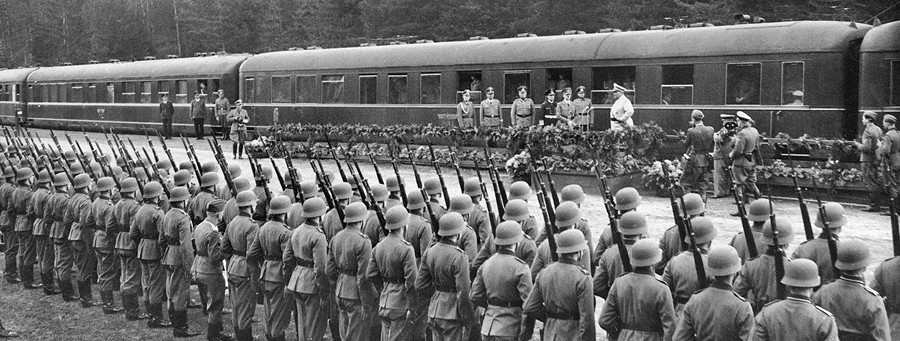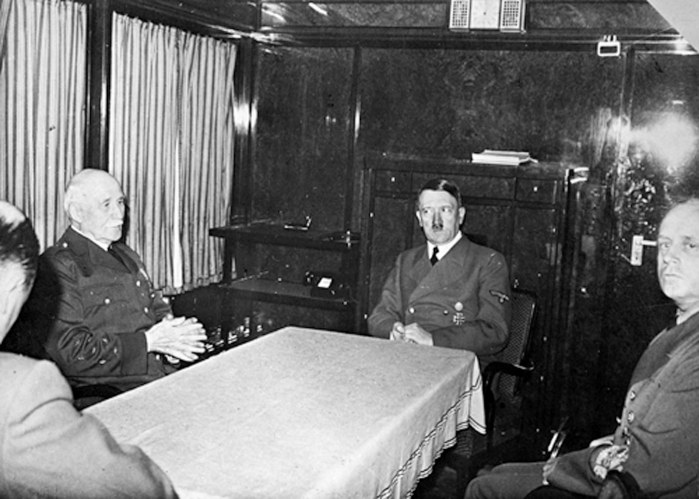The Führersonderzug, Hitler's special train

The Führersonderzug was the special train used by Adolf Hitler for his travels accross Germany and Europe. In 1937, Hitler ordered a special train to the Deutsche Reichsbahn which he would use for his travels. After 2 years of conception, the train was ready in August 1939. It was first named Führersonderzug "Amerika", and later renamed "Brandenburg". During the war, the train served as a Führerhauptquartier (mobile headquarters), up until the Balkans campaign, however Hitler continued to travel on it throughout the war between Berlin, Berchtesgaden (Berghof), Munich and other headquarters. The train was always followed by Hitler's Mercedes and plane.
The train weighted 1200 tons, and its maximum length could reach 430 meters. The train could travel at a speed between 80 and 120 km/hour.
The wagons were not armoured, these were standard travel wagons that were adapted to the Führer's needs (for example, Hitler's private coach included a marble bathroom which needed to be reinforced with a concrete lid). The wagons were build in the 1930s by 3 German companies: Henschel & Sohn, Krauss-Maffei Wegmann and Credé. The interior was designed by a well-known Munich company, in a simple art deco style. Each coach was equipped with heating system and air conditioning, which was quite rare at the time.
CONFIGURATION
The configuration of the train varied according to the needs and the number of people needed on board: 10 to 16 wagons, and a length between 300 and 430 meters. The train could host more than 200 persons on board. The layout of the head wagons however never changed, as they included the defense and communication cars, as well as Hitler's personal wagon. The exact composition of the train is not known, but historical studies show that the following was most certainly accurate (from front to rear):
- The train was equipped with 2 locomotives allowing the convoy to function even in the case of a machine failure. However, when using steam engines, the locomotives had to be changed every 200 kilometers with a new one charged with coal. The Führersonderzug could be powered by several types of locomotives, both with steam and electrical engines, For example: the steam BR 52 ("Kriegslok") class KDL1 for Kriegsdampflokomotive (war steam engine) which first appeared in 1942, the Fleischmann, the Roco or the Märklin.
- At both sides of the train were one SdPl 4i-39 Flakwagen, each equipped with 2 anti-air Flakvierling 38 quadruple tube canons with center space for crew and munitions, for defense against ground and air attacks. The flak canons of 20 mm were able to fire as far as 4,7 kilometers on ground and 2.500 meters high with a cadence of fire of 800 shots/minute.
- One baggage car
- Hitler's personal car (the Führerwagen) was a Pullman DRB car and included (in order): an antechamber guarded by 2 bodyguards, a lounge with a big table and veined maple couches , Hitler's bedroom with a simple single bed, a marble bathroom, 3 rooms for guests, a shower room, and another antechamber with 2 bodyguards.
- The command and communication car (Befehlswagen) included a conference room and was equipped with all contemporary ultra modern communication devices, a strategic room and telecommunication rooms with teleprinters and encryption devices, telephone exchange (for internal and external calls), and a radio room with an enigma machine to encode and decode the messages. These devices were not operational during travels, they had to be plugged to the different stations in order to work. However, a powerful 700 watts short wave radio could be used to communicate everywhere while the train was moving.
- The Begleitkommandowagen was dedicated to the accompanying Reichssicherheitsdienst, Hitler's personal guard, which could have up to 26 SS men.
- One dining car.
- Two guests cars.
- One car was dedicated to bathrooms and haircut services (Badewagen), it was offered to Hitler by the Reichsbahn for his 50th birthday on 20 April 1939. This car was particularly heavy (78 tons) due to the 5 bathrooms, 3 marble showers, 1 shower room and the 11.000 liters of water available.
- Another dining car.
- Two sleeping cars for personnel.
- A press car (Pressewagen) dedicated to the Propagandaministerium and their Reich press release.
- Another baggage car.
- Another Flakwagen.
NOTABLE TRAVELS

On 3 September 1939, "Amerika" was used for the first time as a war headquarters, and allowed Hitler to closely follow the Poland campaign with his staff (secretaries, valets, maids, waiters, soldiers guarding the train and operating the 2 flak batteries Flakwagen, communication officers, Hitler's doctor, aides-de-camp and general staff).
After the Poland campaign, Hitler went back to Berlin, where the Sonderzug was stationed in a high security area of Tempelhof airport.
In October 1940, Hitler used his special train to travel to France where he held three diplomatic meetings, one with Pierre Laval to prepare the meeting with Maréchal Pétain, then with Francisco Franco in Hendaye, near the Spanish border (the trains could not go longer as the width of the Spanish rails was larger than the standard ones at the time), and then with Maréchal Pétain in Montoire-sur-le-Loir, a small French town 200 kilometers south-west from Paris.
In April 1941, the train was stationed in Mönichkirchen, a small town near Vienna, where Hitler commanded the attack on Yugoslavia after Mussolini's failed attempt to conquer Greece. This is where he celebrated his 52th birthday with his staff. He also held several diplomatic meetings there in his train.
On 27 and 28 August 1941, Hitler and Mussolini met in Anlage Süd to discuss the conduct of the campaign against Soviet Union. This facility consisted in 2 reinforced tunnels that were build 30 kilometers from each other in 1941. In each one, a train could be parked, and the doors could be sealed in case of attack. Hitler's train was parked in the Strzyżów tunnel, and Mussolini's was parked in the Stepina tunnel.
On 16 January 1945, Hitler leaves his FHQ Adlerhorst to go back to Berlin and travels for the last time in the Führersonderzug.
On 7 May 1945, after the death of Hitler, the SS decided to blow up and burn Hitler's personal wagon near Mallnitz. Britain and United States shared the rest of the train after the war, which was used in occupied Germany. In the 1950s, the cars were given back to Germany. Chancellor Konrad Adenauer used the rest of the Führersonderzug as his personal train, and in the 1960s and 1970s, the wagons were separated and used until the 80s. Some of the remaining cars are now stored in a museum.